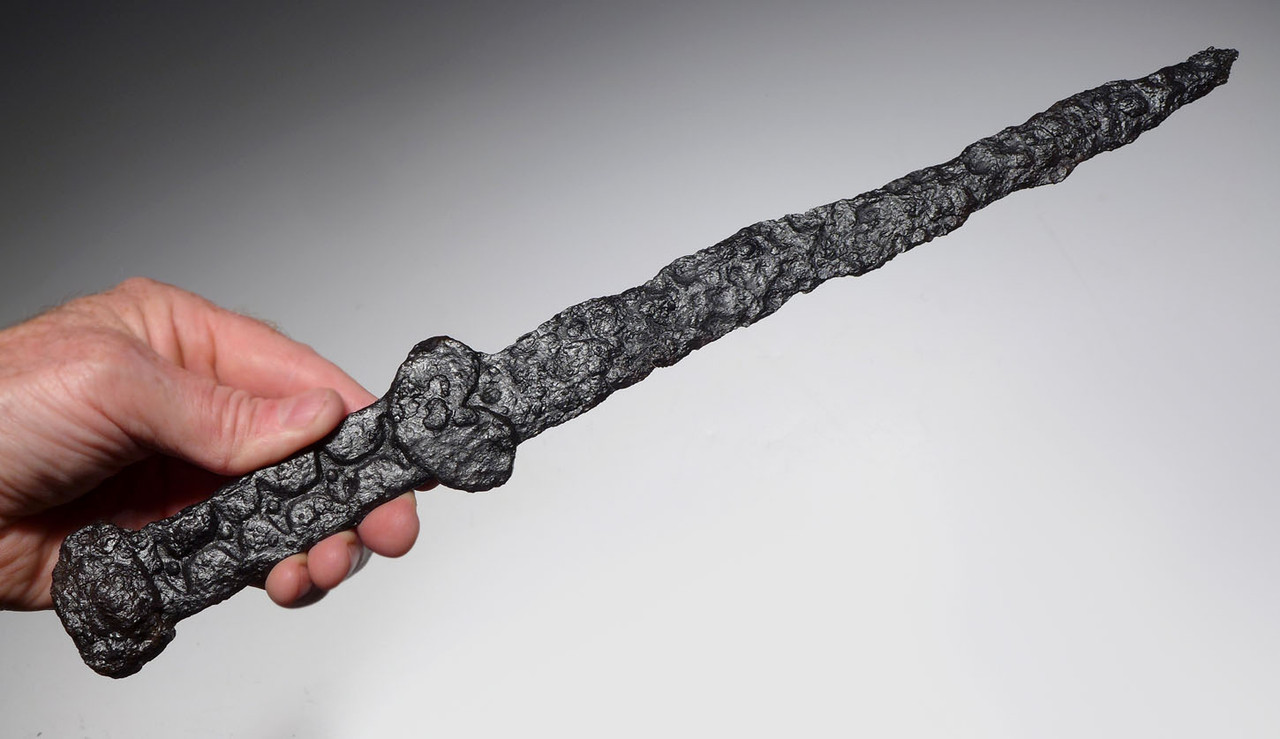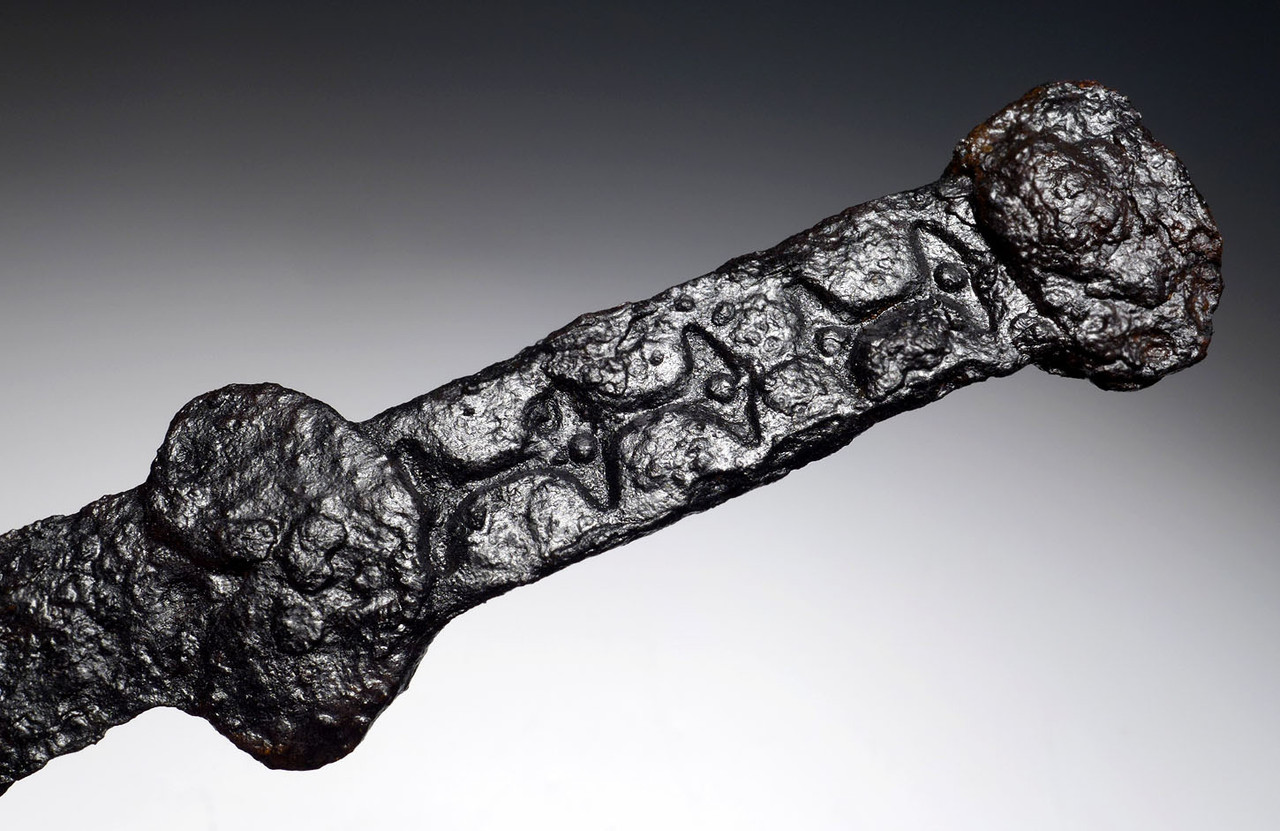Product Description
True Black Sea Region European Scythian weapons are extremely scarce in the open market. This is a rare opportunity to acquire a well-preserved iron weapon of the classical Black Sea ancient Scythians of Eastern Europe. Unlike dry regions of the ancient world such as the Near and Middle East, the wetter ground of Europe is incompatible for ancient iron preservation with most iron antiquities being lost to nature, over time. While it is especially rare for a 2000 year old ancient iron weapon to have survived burial in Europe, the additional rarity of this being of Scythian origin makes this a piece of great importance to the most advanced collections. Even in museums, few examples can be found.
This is the rarest piece of the exclusive, small collection of European Scythian iron weapons we have to offer because like most ancient cultures, swords were a rare and expensive weapon. This akinakes short sword features an intact narrow stabbing blade with the typical Scythian double-lobed hilt. The handle is most impressive with its forged ladder braid design on one side, terminating in a large oval striking pommel. It is truly amazing that the design on the handle survived the ages, demonstrating that this was an extremely prestigious weapon of an ancient Scythian warrior. This short sword is similar to published weapons of the western ancient Scythians of the Black Sea region (see reference below).
This is the first instance in 28 years of our experience where we have secured such a weapon from this culture, to offer for sale. NO REPAIR AND NO RESTORATION. Very highly recommended for any ancient militaria collection! Metal has been cleaned and stabilized in our lab, treated by the same methods that we have treated thousands of rare iron artifacts for numerous museums.
Reference:
Shramko B.A. Iz istorii scyfskogo vooruzheniya//Vooruzheniye scifov i sarmatov, 1984, p. 32
WARNING: There is an ALARMING number of fake ancient artifacts on the market. As fine quality intact, original specimens become more scarce, techniques become more sophisticated to fake these objects. In our lab, we have personally handled numerous extremely well-done fakes with convincing patinas, that could fool most experts. The degree to which the fakers have been able to replicate patina to disguise their work requires an expert examination by highly experienced individuals. Like all rare collectibles, fakes plague the market.
We process every piece we offer to a full analysis, cleaning and conservation process in our on-site lab. How many dealers do this or have any experience in operating their own lab? The procedure we put each piece through is the same as the best museums perform on their own collections. Most dealers lack such knowledge and experience as this, to accurately identify fake and altered ancient objects. Deal only with sources that are extremely knowledgeable in forgeries and altered pieces, and get a written guarantee of authenticity that has no conditions or expiration period. We include this guarantee in writing with every item we sell.
HISTORY
The Scythians were a warring, nomadic people from the Steppe region that occupied the northern Black Sea area in the Early Iron Age from 700 to 300 B.C.. They ruled an enormous region in what is now the former Soviet Union. Groups of Scyths penetrated as far west as Hungary, Romania, Bulgaria and Prussia. Masters of both horse and bow and arrow, they are considered amongst the first of the great horse archers. Small compound bows were used firing salvos of bronze tipped arrowheads with uncanny accuracy while at full gallop. Their cavalry and light horse-drawn wagons allowed them greater mobility than their enemies. Scythian battle horses wore elaborate ornaments of bronze, silver and gold. The horses were armored with handsomely worked eyepieces and nose shields richly decorated with various animal motifs. While most men had multiple horses, favorite mounts were pampered and highly decorated. Because of their nomadic lifestyle, Scythians were always close with nature and had deep respect beliefs in the magical power of many beasts. Clothing and armor was decorated with images of various animals (both real and fantasy) as well as bronze, silver and gold pins and appliqués were used for protection. Most important animals included panthers, lions, griffins and antlered stags. The stag was believed to transport the soul of the dead to the Other World. Often, elaborate renderings of the antlers is used in their art.
The Scythians battled, terrorized and influenced the cultures of the Assyrians, the Medes, the Persians and the Macedonians. Scythian fighting techniques could adapt to the moment allowing them to fight as a marauding band or as a disciplined army, both mounted and unmounted. Burial discoveries have helped us to learn about their weapons and armor. Early Scythian burials were cremations lacking any possessions but later tombs were filled with items designed to be used in the afterlife. These included items such as a bow, several dozen arrows, spears and or javelins, defensive armor and swords.
 US DOLLAR
US DOLLAR
 EURO
EURO
 AUSTRALIAN DOLLAR
AUSTRALIAN DOLLAR
 CANADIAN DOLLAR
CANADIAN DOLLAR
 POUND STERLING
POUND STERLING














